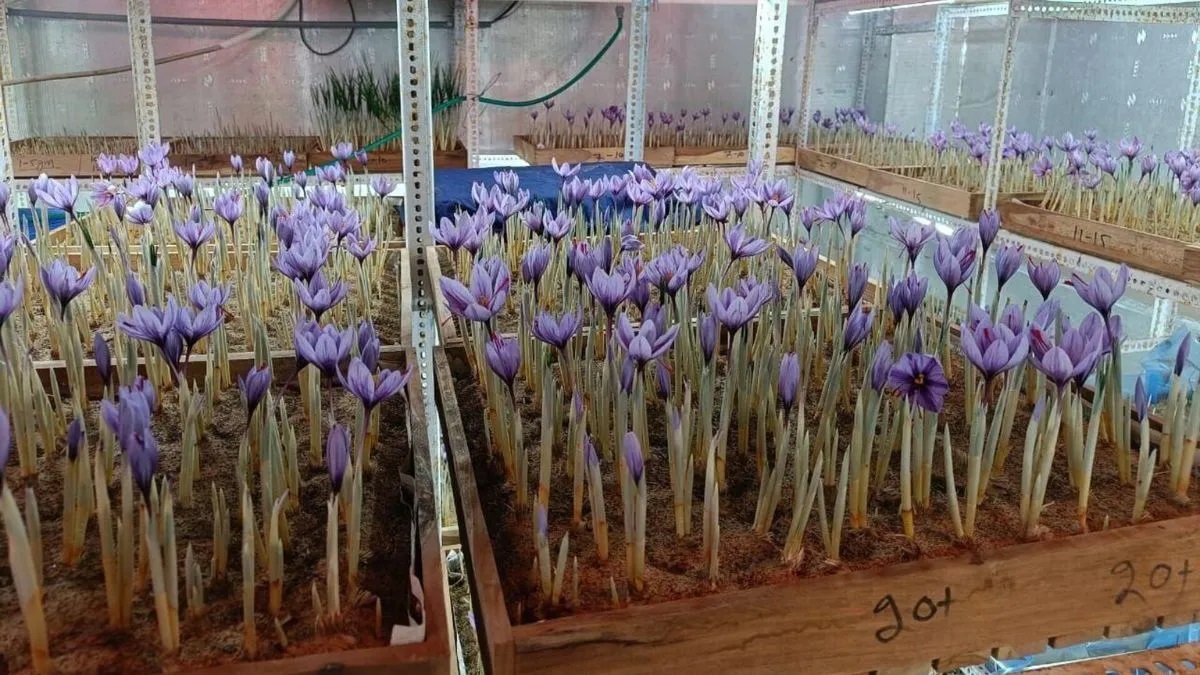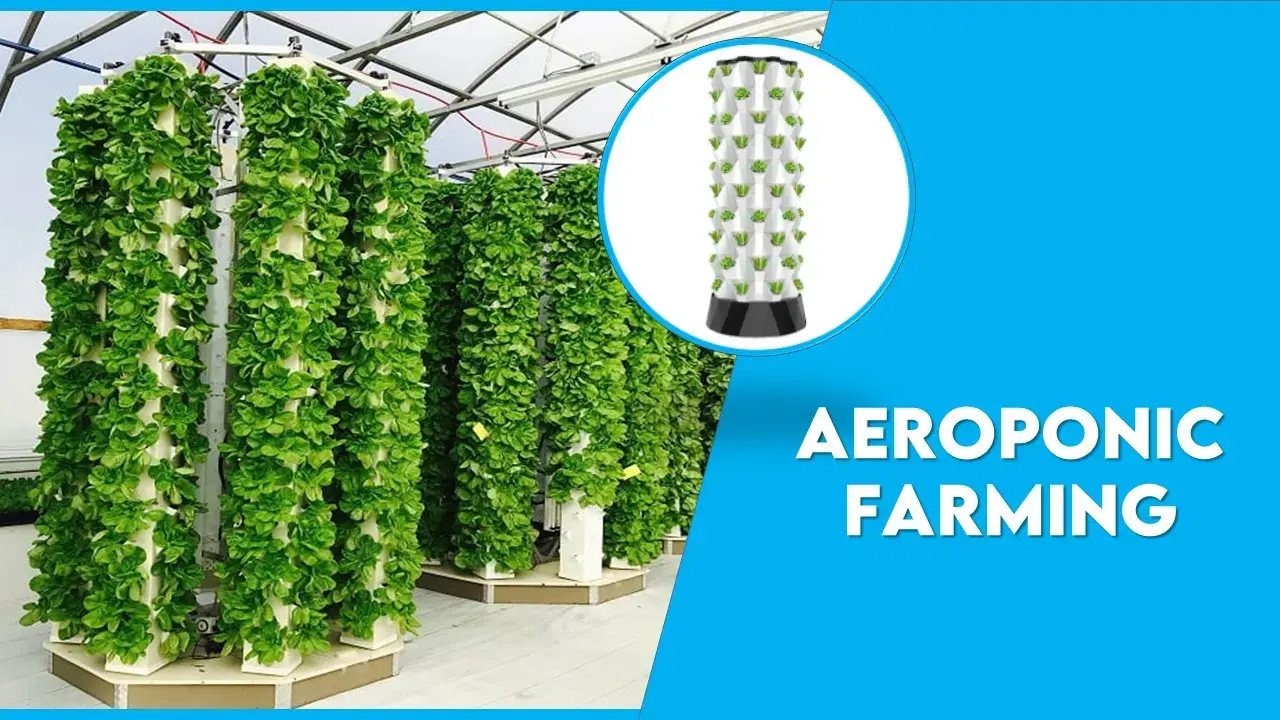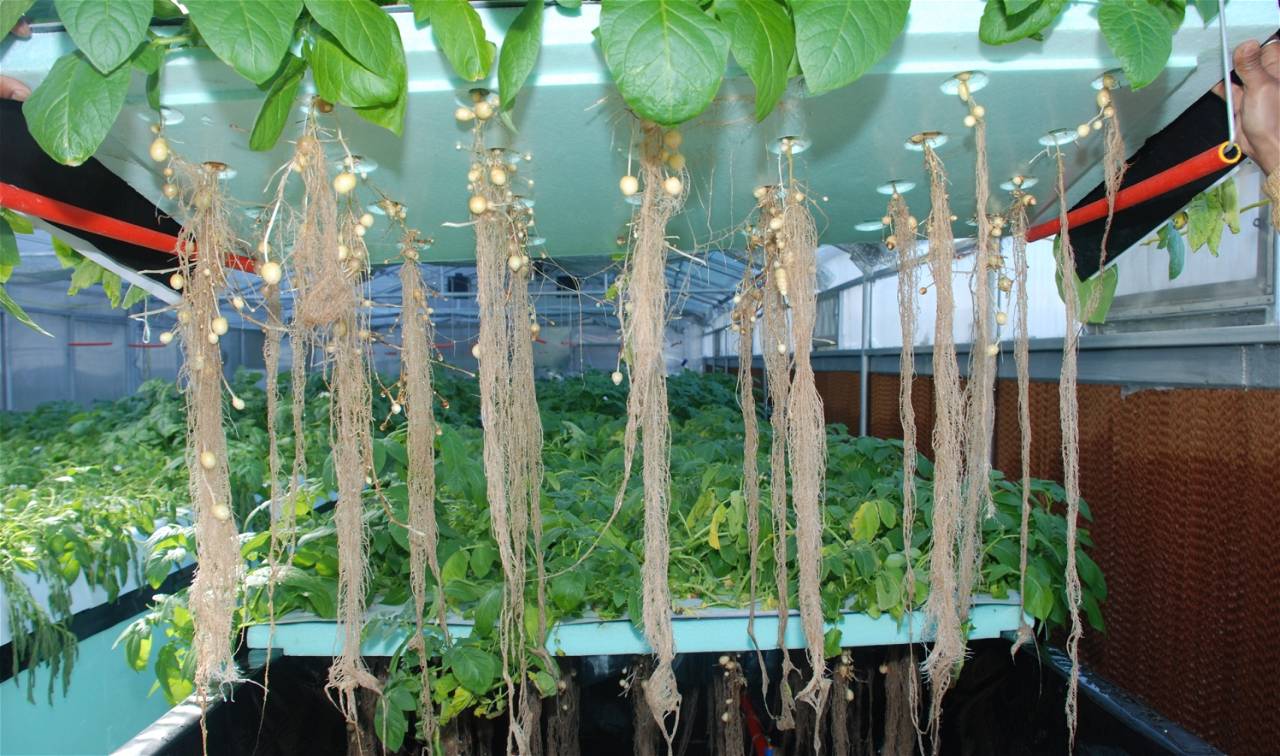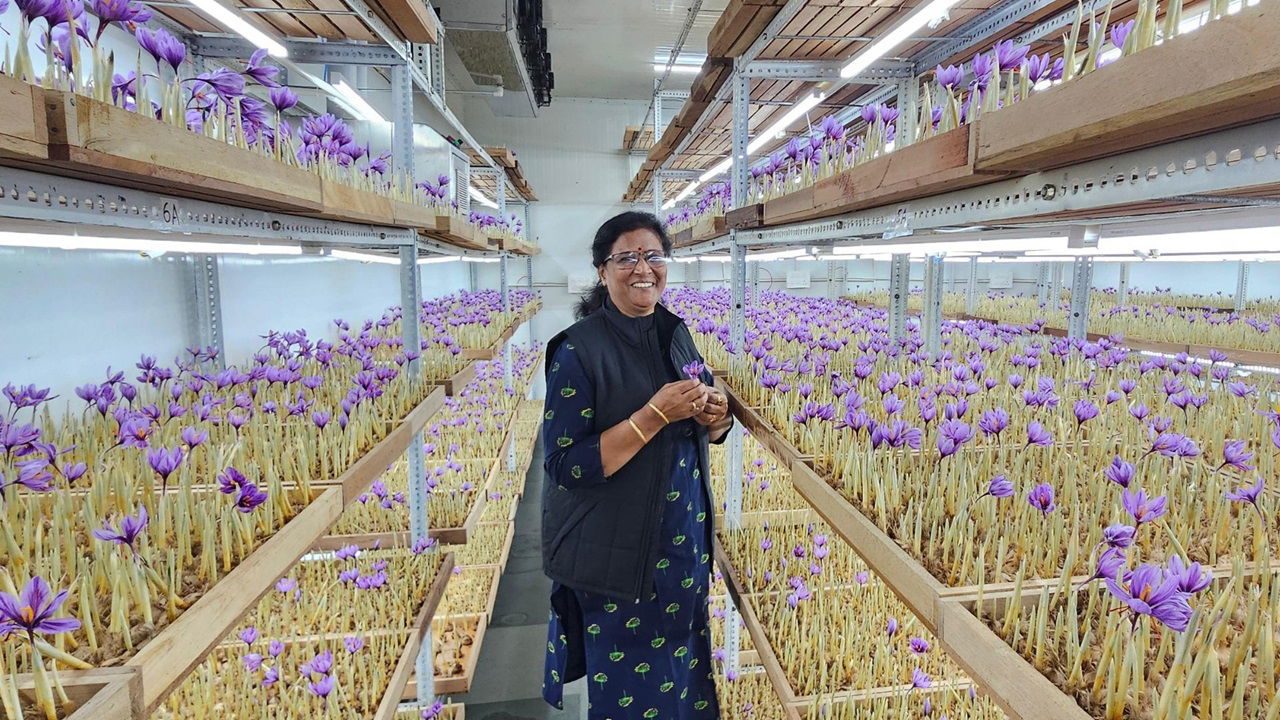Aeroponics Miracle By Hemant Srivastava. Saffron Blooms In Lucknow!
Hemant Srivastava pioneers saffron farming in Lucknow via aeroponics, breaking traditional barriers and opening new horizons for sustainable agriculture in India.

Hemant Srivastava of Lucknow has broken geographical and climatic barriers by developing saffron, one of the most expensive and delicate of the world’s spices, farming it via the trailblazing aeroponics method. Saffron has traditionally been cultivated in the cold, mountainous areas of Kashmir and has previously been considered to be difficult to cultivate in plains such as Uttar Pradesh. However, Hemant’s dreamer’s view and ambition have realised this and opened up a new land for saffron cultivation across another non-traditional land. This is a sign of how the power of innovation can turn the agricultural landscape.

Lucknow’s innovative researcher and farmer Hemant Srivastava has become a news headline for his pioneering work in saffron cultivation. With a keen interest in exploring advanced agricultural techniques, he turned to aeroponics—a soil-less farming method—to achieve what was once considered impossible: good saffron can be grown in the plains of Uttar Pradesh. His eagerness to try new farming techniques has made him a forerunner of new agricultural innovation.
Once synonymous with Kashmir’s pristine valleys, its formal name, ‘saffron’, has come to synonymise the Symbol of Kashmir. The combination of soil, temperature, and altitude has been ideal for centuries in the presence of saffron. It has been cultivated almost exclusively in this region for centuries and is one of India’s most prized agricultural produce.
But such a geographical stereotype has been broken by Hemant Srivastava of Lucknow, who has grown saffron successfully in the plains of Uttar Pradesh using the innovative aeroponics system. Aeroponics differs from traditional farming, which requires specific climatic and soil conditions for crop growth; instead, aeroponics crops are grown in a controlled, soil-free environment.

So let’s suspend plant roots in the air and supply nutrients in mist, making this the most incredible way of growing saffron no matter where you plant it. Hemant doesn’t just break down the limits of where saffron can be farmed; he points out how modern agricultural practices have negated nature’s boundaries to break out of the boundaries of what saffron can be grown on, placing saffron in hitherto non-traditional areas of India.
Saffron, also known as the ‘king of spices,’ is one of the world’s most expensive, sought-after spices due to its intense colour and taste. It’s made from the delicate stigmas of the Crocus Sativus flower. It is an incredibly labour-intensive product that requires an incredible amount of flowers—75,000, to be exact—to make just one pound.
Besides the culinary use, this spice is mainly appreciated for its medicinal properties as it plays a vital role in Ayurvedic and Unani traditional medicine systems. The antioxidant-rich composition of saffron has been considered to elevate mood, help improve memory, and enhance health.
In addition, saffron has a cultural and economic value in beauty product and religious rituals. Not only is its cultivation an important factor in the agricultural sense, but its cultivation is also a tribute to the remaining of an unalterable legacy.
Aeroponics: Revolutionising Farming with Soil-Free Cultivation
A technique advanced far from traditional cultivation, aeroponics eliminates the use of soil; instead, it suspends roots in a manner where nutrients are absorbed directly through a fine mist. This mist contains nutrient elements, water, and oxygen, making it the ideal ambience for the plant to thrive in.

Aeroponics is totally different from conventional farming, where plants rely on soil for anchorage and nourishment, but aeroponics provides them with precise amounts of nutrients and moisture on roots to promote quicker faster and healthier growth. It also regulates all critical environmental factors such as temperature, humidity, and lighting, making it an ideal technique for growing crops in poor ecological or soil conditions.
This innovative method maximises resource efficiency, using far less water and nutrients than conventional farming, which not only enhances yield, but also results in a more environment friendly farming for the future of agriculture.
A Game-Changer for Indian Agriculture
It could revolutionise Indian farming if the use of aeroponics is accepted. Water efficiency is one of its most important benefits. Aeroponics, in contrast to traditional agriculture, which could be water-intensive, is 90 per cent less water-intensive by misting plant roots directly with a nutrient-rich solution. It is the ideal solution for its water, where India is water scarce. It also has the advantage of being soil-less and closed-loop, reducing the risk of soil degradation, pests and diseases, thus producing healthier crops with minimal reliance on pesticides and fertilisers.

It’s another critical advantage because it allows the creation of a controlled environment. This means that farmers can control factors, such as temperature, humidity, and light, that would be required to grow crops in adverse climatic conditions or agricultural regions unsuitable for crops. This may be a very valuable feature in India, where weather patterns are unpredictable and climatic change decides the lifetime, lifespan and quality of crops that grow.
Aeroponics gives the chance for all-around cultivation at all times of the year. This method enables the uniform growth of premium crops like saffron, strawberries, and leafy greens, which increases farmers’ incomes and reduces reliance on imported products.
Aeroponics is a game-breaking innovation for Indian farming. The challenges range from water scarcity, declining soil fertility, and climate unpredictability, and aeroponics takes a position with sustainable and scalable solutions. With this method, Indian agriculture can be made less susceptible, efficient, and environmentally friendly, just like the food security and economic growth of future generations.
Economic and Social Impact of Aeroponics in India
Aeroponics has immense potential to alienate farmers from areas unsuitable for growing the expensive, legendary spice saffron. Aeroponics enable the farmers of India to overcome the climatic and soil limitations of saffron farming and move to high-value markets. This innovation will likely bring small-scale farmers of plains and arid regions into active participation in saffron production, thereby increasing their potential earnings and bridging regional economic disparities.
With the development of saffron production centres outside Kashmir, India’s agricultural economy will take leaps and bounds. Using controlled, efficient methods such as aeroponics, regions that do not have simple agricultural activity can become saffron cultivation centres to fulfil domestic and export requirements. Apart from lowering the country’s dependence on imports, it would significantly enhance the country’s role in the international saffron trade.
Taking on aeroponics reflects the advancements India is making in agricultural innovation and its efforts towards self-reliance. Advanced technology, for instance, will improve productivity, solve a water-scarce and climate-change-prone scenario for farmers, and reverse soil degradation. This will inspire greater confidence in the farming community, attract investments, and contribute to a more resilient agricultural sector.
Redefining Saffron Cultivation with Aeroponics
Aeroponics has revolutionised saffron farming with superior yield and quality control when compared to the way one has done it conventionally. Without soil and in an otherwise controlled environment, aeroponics ensures the delivery of optimal nutrition to plants that improve their health and level of uniformity in producing saffron crops. This precision farming approach eliminates the risks associated with disease, pest infestation, and environmental stresses that impact quality in conventional farming, thereby granting growers the ability to produce premium-grade saffron.

Apart from the quality improvement, the other reason for using aeroponics is its cost-effectiveness. As a method, it requires much less water, up to 90% less than traditional agriculture. Using less water and pesticides not only reduces costs but also advocates sustainable farming practices, which goes in tandem with the global effort towards degrading environmental damage.
With wide proliferation, aeroponics would have the potential to fulfil the domestic consumption of saffron by executing round-the-year cultivation in various geographical conditions. India, an importer of significant portions of saffron, would benefit immensely by reducing overseas dependence with large-scale crop cultivation. Therefore, by saving high foreign exchange, India would take a vital position as an independent country among the competitive producers of saffron in the world market.
Hemant Srivastava’s Journey to Redefine Saffron Farming
Hemant Srivastava’s journey into the world of saffron has started with an eyes-to-innovate vision to challenge the long-held notion that saffron can only thrive in cold valleys of Kashmir. Encouraged by his passion for agricultural innovation and curiosity to find uncharted spaces, Hemant is now cultivating high-value crop saffron in the plains of nawab city, Lucknow. Mr Srivastava’s experiment was the potential for revolutionising Indian agri market and liberating the right of farmers to make the most expensive spice of the world, saffron outside their respective regions.

On the other hand, the journey wasn’t easy. Adjusting saffron to Lucknow’s utterly different climate was a challenge in itself. Hemant had to grapple with the issue of cold winters, specific humidity requirements, and controlled temperatures for the proper growth of saffron. Mastering the aeroponics method was an additional complexity in itself, requiring deep research, trying, and understanding of precision farming techniques.
Scaling Saffron Cultivation: The Future of Aeroponics in India
Hemant Srivastava’s success in growing saffron through an aeroponic system should now open up the doors to more ambitious plans in scaling up the activities. He would like to expand his saffron cultivation to more extensive facilities, increasing yields and expanding market reach. Hemant further aims to fine-tune this aeroponic system and share his expertise to establish a replicable model for other farmers, especially in regions with adverse conditions for traditional farming.

Other farmers can take up this method, mainly when the process exhibits efficiency and effectiveness while saving costs with the promise of high-value crops. The success story of Hemant may motivate agricultural communities towards such technologies and help the transition to innovative agriculture. Water-scarce and non-traditional regions for saffron cultivation shall also help with crop diversification and increased income.
Such initiatives could then scale significantly through government support or the private sector. Policies that would offer subsidies for aeroponics equipment, grants to finance research and development, or even training programs for farmers can help accelerate adoption. Private partnership with agricultural technology firms or food and beverage industries can also provide financial backing and technical expertise. By integrating these support mechanisms, India is positioned to become a global leader in saffron production, creating new economic opportunities and fostering sustainable agriculture.





